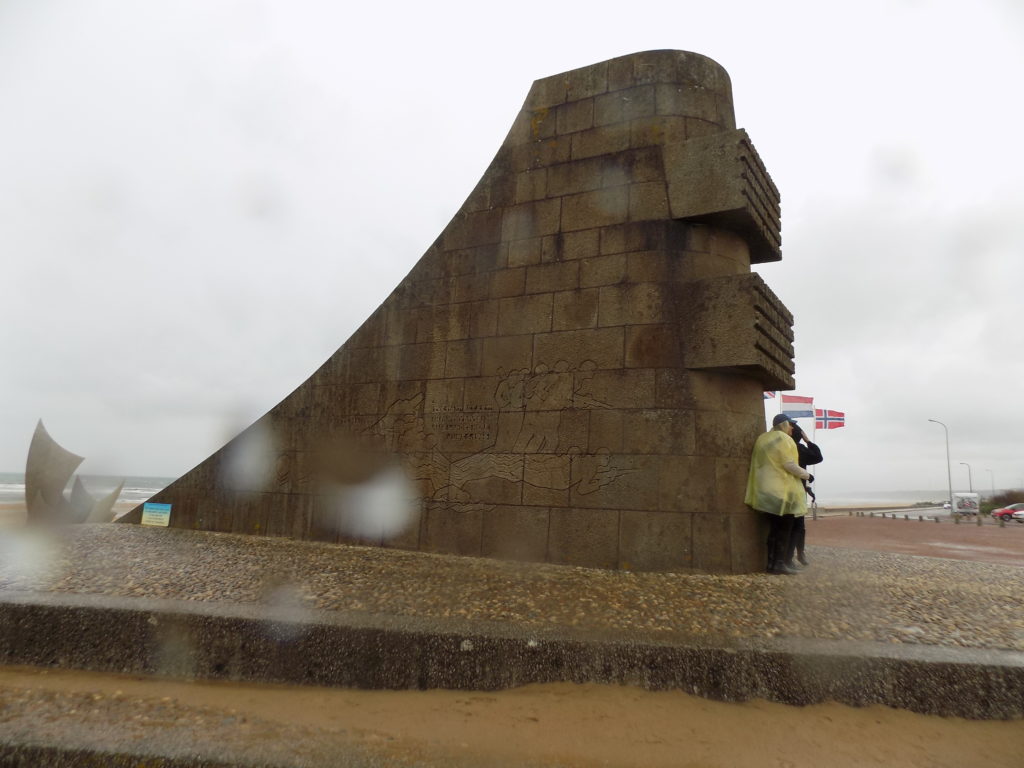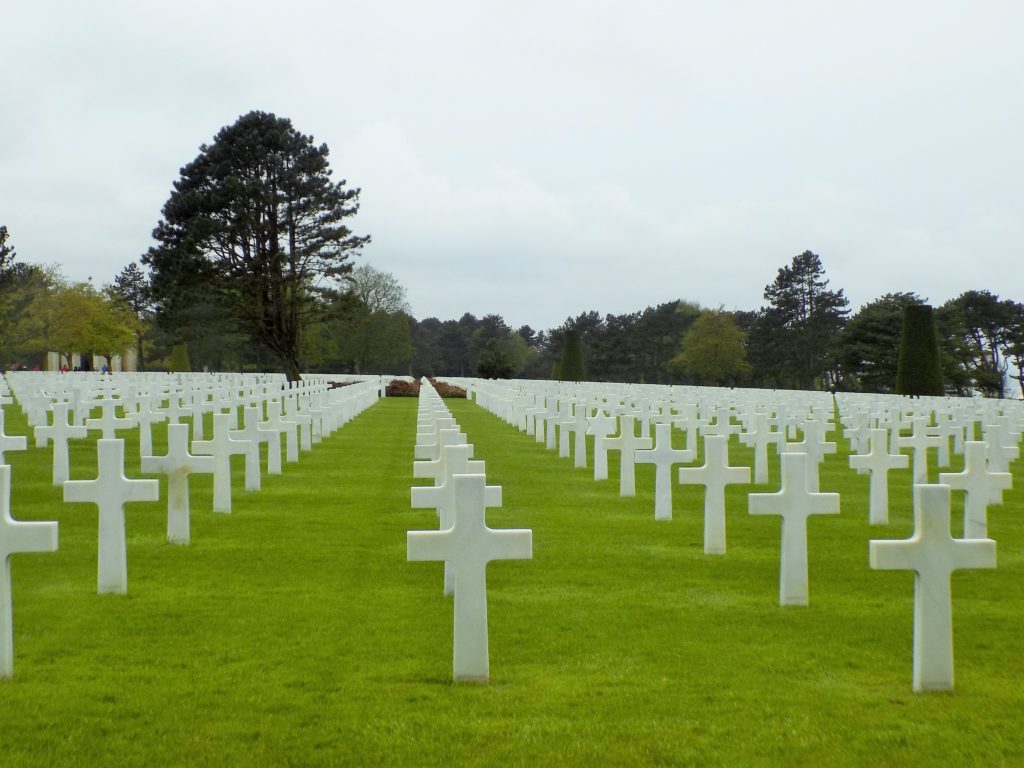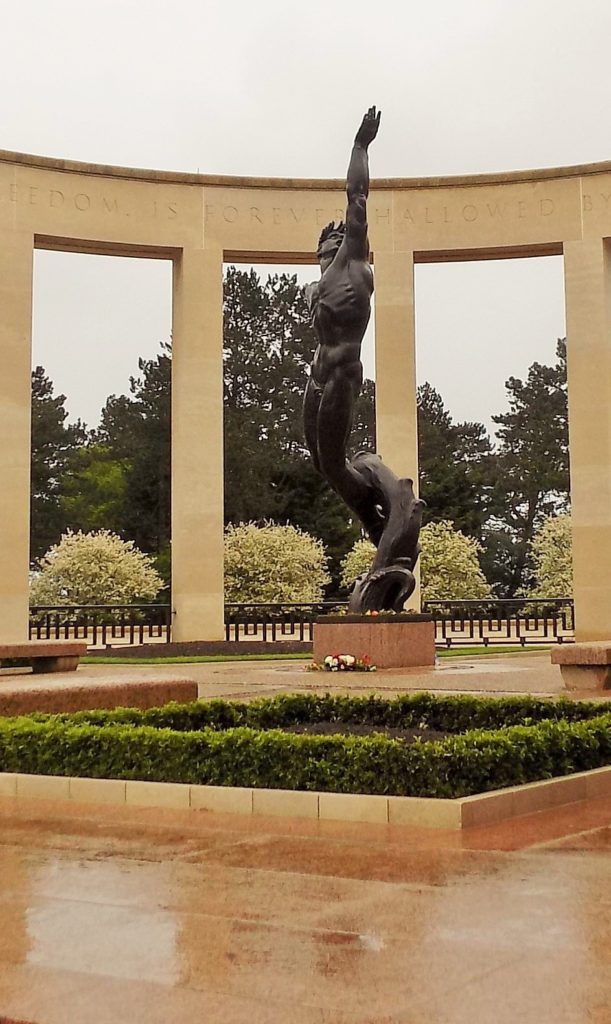Memorials Sur la plage
If you are moved by visits to battlefields, if your emotions are stirred by battlefield memorials, or if you feel the shared pain of loss – be it national or familial – on a visit to a military cemetery then prepare to be overwhelmed by any time you might spend at Omaha Beach or the American Cemetery at Colleville.
The weather hadn’t improved much when we reached Omaha Beach. It was still cold, windy, and rainy as you can see by this and my other raindrop smeared photos.
Two memorials mark the beach. The first is the roughhewn stone monument at the end of the Avenue de la Libération in Saint-Laurent-du-Mer you see above. On one side the inscription reads, “1st US infantry Division – No mission too difficult, No sacrifice too great duty first – Forced Omaha Beach at dawn 6 June.” On the other, “Erected in memory of those the 116th RCT, 29th Infantry Division that landed here June 6, 1944.” And on the side facing inland, in French, “LES FORCES ALLIEES DEBARQUENT SUR CETTE PLAGE QUELLES NOMMENT OMAHA BEACH et LIBERENT L’EUROPE 6 JUIN 1944” and in English, “THE ALLIED FORCES LANDING ON THIS SHORE WHICH THEY CALL OMAHA BEACH LIBERATE EUROPE JUNE 6th 1944.”
The other memorial is called Les Braves. The sculpture is the creation of Moroccan born artist Anilore Banon (perhaps fittingly she was born in Casablanca – “I remember every detail. The Germans wore gray, you wore blue.”) and was installed in 2004 as the official sculpture of the 60th anniversary commemoration of the Normandy landings of the Second World War. According to the artist she created it to honor the courage of the sons, husbands and fathers who endangered and often sacrificed their lives in the hope of freeing the French people.
The sculpture consists of three sections:
The Wings of Hope
So that the spirit which carried these men on 6 June 1944 continues to inspire us, reminding us that together it is always possible to changing the future.
Rise, Freedom!
So that the example of those who rose against barbarity, helps us remain standing strong against all forms of inhumanity.
The Wings of Fraternity
So that this surge of brotherhood always reminds us of our responsibility towards others as well as ourselves.
On 6 June 1944 these man were more than soldiers, they were our brothers.
Rather than have you look at another rain spattered picture, here’s a short video from the sculptor’s website:
And then the dead
Following our brief stop rain-shortened stop on the beach, we wound our way up the bluffs and about five kilometers west to the American Cemetery at Colleville-sur-Mer. By the time we arrived there, I’d decided to remain with our guide long enough to take a photo of yet another of her widely known “secrets” – the time capsule of contemporary newspaper reports of the Normandy Landing placed by newspaper writers at the site for the 25th anniversary of the assault. – before setting off to explore on my own.
I think every American – particularly those who are of an age to have had a parent or known a grandparent who fought in the Second World War – will have a deeply intimate and personal experience when visiting the Normandy American Cemetery and Memorial. And I think this is as it should be. Thus, as it’s not my intent to allow my emotions to color yours, I will make every effort to write about my time at the cemetery as dispassionately as possible.
Since my return, I’ve often been asked why Americans would be buried overseas. Initially, the answer is simple – given the chance by any lull in the fighting – the survivors had to bury their fallen comrades. It’s known that the Americans started burying their dead as soon as 8 June 1944 and the first of these may have been on this site on the bluff near Saint-Laurent-sur-Mer. The site of the cemetery is a consolidation of ten temporary cemeteries in the area.
Those of you who have followed me on past journeys know of my penchant for visiting cemeteries and grave sites whether that is Novodevichy in Moscow in 2013, Mirogoj and Žale in Zagreb andLjubljana, or the lone grave of Sacagawea in Wyoming last summer. Many of these cemeteries are not merely filled with works of art but are works of art themselves. Of the cemetery in Normandy, this is true and not true.
The cemetery itself with the graves of 9,387 Americans is stark, simple, and uniform. The burial ground is shaped like a cross with 10 sections – five on each side of the main east-west axis. Every grave is marked only with a white marble headstone. Neither more nor less. The gravestone for a Christian is a simple Latin cross and for a Jew it is a Star of David.
(I’ve enhanced the lighting on this photo in an effort to better communicate the impact of looking out across row upon row of these simple and uniform markers. The image my camera produced was much darker. The rain had so soaked the ground that signs asked visitors to refrain from walking on the grass.)
The service numbers of the decedents are inscribed on the backs of the headstones. The cemetery is managed by the American Battle Monuments Commission (ABMC) which was established by Congress in 1923 to commemorate “the service, achievements, and sacrifice of U.S. armed forces where they have served overseas since 1917.” But American service members who perish overseas need not be buried overseas. Approximately 14,000 American soldiers who were originally buried in France and who would likely have been interred in this American Cemetery, were transported home upon request of their families.
In addition to the simplicity and uniformity of the headstones, another standard practice in ABMC cemeteries is that the internments do not separate the deceased by rank, so officers and enlisted men are interred side-by-side. Among the 9,387 graves in this cemetery there are 307 unknown burials, three Medal of Honor recipients, and four women. Thirty-three sets of brothers are buried next to each other. They include Preston and Robert Niland (whose story served as the inspiration for the film Saving Private Ryan) and Theodore Roosevelt, Jr. who was a Medal of Honor winner and his brother Quentin who was killed in the First World War and was reburied next to his brother. There is also one father and son in adjacent graves.
Of the four women buried in Normandy three – PFC Mary H. Bankston, PFC Mary J. Barlow and Sgt. Dolores M. Browne belonged to the only all African American Women’s Army Corps unit deployed to Europe. All three died in July 1945 as a result of the same auto accident. The fourth woman, Elizabeth Richardson, was a volunteer for the American Red Cross.
But the 70-hectare memorial is more than the cemetery. There is a chapel
and the Memorial and Garden of the Missing. At the center of the memorial is a seven meter tall bronze statue called The Spirit of American Youth Rising From the Waves because so many who died were so young. The stones set in the memorial floor are from Omaha Beach.
Flanked by a semicircular limestone colonnade, the memorial has loggias on the south and north sides containing maps of operations and battle narratives in English and French. The map on the south loggia depicts the Normandy landings and subsequent movement inland; the north loggia map shows the Allied movements through Western Europe from D-Day until the German surrender in May 1945.
Also inscribed on this monument are the names of another 1,557 missing many of whom drowned during the crossing from England.
In the next post, I’ll have a passing encounter with an unexpected group of people as I prepare to leave the cemetery and I’ll detail the evening’s on board concert.



